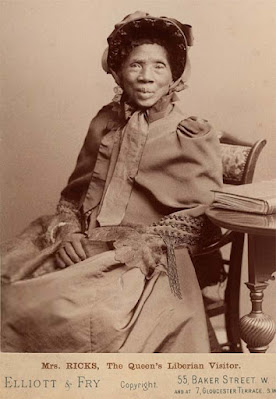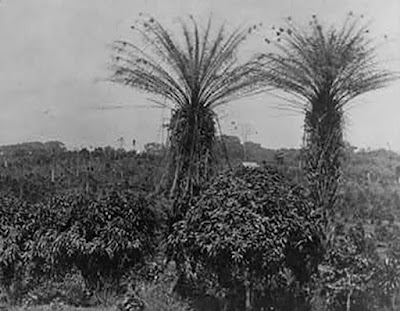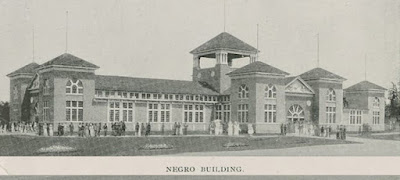Agricultural states indulged in a fashion
for constructing elaborate displays of
corn and fruit for the 1893 Chicago Fair.
Monumental sculpture of dried prunes
We have found, as noted in recent posts, few published mentions of quilts displayed at the 1893 Columbian Exposition. Some examples must have been lost in the records of individual state and country displays with their attention to agriculture, manufacturing and commerce.
But here's an exception: Hubert Howe Bancroft in his
Book of the Fair gives a sentence to a quilt displayed in Liberia's exhibit in the Agricultural Building. Liberia is an African state founded in the 1820s by American Colonizers who encouraged freed American slaves to move back to Africa.
Martha Ann Erskine Ricks (1817?-1901)
Wood engraving from a cabinet card photograph 1892
The mention of the quilt is remarkable as is Martha's story.
Martha Erskine sailed to Liberia with her Tennessee family in the winter of 1830. Father George Erskine had been both a slave and a Presbyterian minister, freed in 1817 by the Tennessee General Assembly. He spent years saving earnings from lecturing and preaching to buy his family and passage to Liberia for wife Hagar, her mother Martha Gains and eight children ranging from 30 to 7 years old. African diseases were too often disaster for American travelers and most of the Erskines soon died of fever, leaving only Martha and brother Hopkins Erskine to survive into adulthood.
Biography of Martha's family by Nemata Amelia Ibitayo Blyden
from her 2019 book African-Americans and Africa
Library of Congress
Brother Hopkins W. Erskine (1820-) photographed in
1866 while on a U.S. recruiting trip for Liberian immigration.
Hopkins became a Presbyterian minister like his father and was active
in Liberian politics.
Library of Congress
Watercolor of the Liberian Senate in the 1850s by
Robert K. Griffin
According to the University of Virginia, Martha emigrated with husband Zion or Sion Harris (1811-1854), also an emancipated Tennessean. He is listed as a passenger with the family arriving on the Brig
Liberia in the capitol Monrovia on February 17, 1830.
After he was killed by a lightning strike she married Henry Ricks. They farmed in Clay-Ashland along the Atlantic coast, a town named for Senator Henry Clay. Henry Ricks's brother, coffee planter Moses U. Ricks of Clay-Ashland is remembered today for his financial gift to establish the Baptist Zodokai Mission school, now known as the Ricks Institute. The Rickses seem to have been prosperous farmers.
Martha Ricks portrait from the University of Virginia.
Two photos of Martha show elegant clothing with
hand-stitched detail, her own work?
Martha's story is persistently tied with her Coffee Tree quilt and the tale that she had a great desire to meet Queen Victoria and how she presented the Queen with the quilt in the summer of 1892, the first we hear of it.
Martha told a reporter for the Pall Mall Gazette about the quilt in July, 1892.
Newspaper articles sentimentalize her goal, telling us she was subject to ridicule in Clay Ashland and saved her pennies to get to England and achieve that goal.
The
Gazette reporter committed many egregious sins including bigotry and a complete misunderstanding of Martha and her life in Liberia, type casting her as a primitive. Of course, that is what his London readers wanted to read. Accuracy was not a priority.
Liberians at a picnic lunch in the "wilds of Africa," 1890s at a
missionary school from David A Day Scrapbook
William L.Clements Library, University of Michigan
Rather than a primitive Martha seems rather skillful in the ways of diplomacy and publicity, enlisting the Liberian Minister Edward Wilmot Blyden to obtain an audience with the Royal Family. In London she stayed with Jane Rose Waring Roberts, widow of Liberia's first Black president Joseph Jenkins Roberts. Jane, born a Virginian, settled in London after her husband's death in 1876.
Jane Rose Waring Roberts 1819-1914
From Harry Johnston's Liberia, 1906
Daily Graphic
The Queen and Martha. (I've been told never to try to shake
hands with the Queen---advice I hope to need someday.)
But the reporter told us the Queen shook hands with Martha.
We learn she met with several members of the Royal Family in July, 1892 and they invited her over to the palace (her "house") for a meal. (Unlikely.) In her journals Queen Victoria did mention meeting Martha, describing her as short (they may have seen eye-to-eye, a novelty for the Queen who was under 5 foot tall) "Very black with a kind face." No mention of quilt or tea.
Martha at 75
Cabinet card photo in the collection of Britain's
National Portrait Gallery
This portrait, a commercial photo, does not seem to
reflect a naïve old lady from the backcounty. These
cards of a celebrity were sold.
Daily Graphic, July 23, 1892, page 110
Historian Jan Marsh speculates that the public relations blitz may have been "assisted by the equivalent of the Palace's press department, as the Graphic newspaper was allowed to send illustrator Reginald Cleaver to record the event, his image of the Court looking on as Ricks and Victoria shook hands being printed on the front page of the Daily Graphic." Or it may have been the Liberian minister doing his job and calling attention to his country.
Queen Victoria, quite a needlewoman herself, received many quilts as gifts with their whereabouts generally unknown. The Ricks/Victoria gift is lost. We know what the quilt looked like (if newspaper accounts are accurate) as Martha described it to the Gazette reporter. It was satin (silk or cotton we don't know), appliqued with a coffee tree and red and green berries. The border was passion flowers. A man was depicted gathering the beans.
Library of Congress
Liberian Coffee Trees in the 1890s
The Ricks made their living in coffee.
Celeste-Marie Bernier found a similar description in the Youth's Companion telling us that the green coffee bush was being harvested by a green man.
Did the palace send Martha's quilt back to Liberia to be included in the Chicago Fair exhibit the following spring? Or was that display a copy Martha made of the royal gift?
Coffee tree quilt at the 1895 Cotton States Exhibition in Atlanta
She apparently made two quilts and the second one was photographed. This copy of the Queen's gift was acquired by Henry McNeal Turner, a Methodist missionary who visited Liberia in 1891, 1893 and 1895. It's thought this second quilt was a gift for Turner.
Henry McNeal Turner (1834-1915) in 1900, New York Public Library
A Georgia resident, he was a bishop in the AME church.
In 1895 Turner organized a display of his Liberian artifacts for the Atlanta exposition, The Cotton States Exhibition, which commissioned a separate Negro Building to show the work of Africans and African-Americans.
In 1896 the B.W. Kilburn Company published a series of stereocard photos taken at the Atlanta expo,
including several of the exhibits by Africans and African-Americans. The photo below from the Library of Congress collection looks like Turner's Liberian display.
Unknown man sitting before a textile with a sign.
"Uncivilized African Exhibits.
Hands Off"
The sign is rather distasteful (we can't change 1890's culture 130 years later) but maybe Turner was indulging in irony. This must be Martha Ricks's Coffee Tree quilt #2, but I don't see the figure of the man picking the coffee beans so she may have modified the design on the second piece.
We can guess that the second quilt was also the one shown in the Liberian exhibit at the 1893 Chicago World's Fair, probably loaned by Bishop Turner.
Quilters in Caldwell, Liberia have interpreted Martha's Coffee Tree Quilt
Martha's intriguing quilt and the heart-warming story of a needlewoman determined to meet Queen Victoria has been told many times. I first read it in an article by Cuesta Benberry in
Quilters' Newsletter magazine in 1987.
Kyra E. Hicks has made it widely available in her children's book Martha Ann's Quilt for Queen Victoria. Read more of Kyra's writing about Martha here:
In 2017 the BBC World Service broadcast a radio documentary about Martha Ricks.
A few other references:
Nemata Amelia Ibitayo Blyden,
African Americans & Africa: A New History. She's also written about Martha's niece Anna Erskine.
Celeste-Marie Bernier,
Stick to the Skin: African American and Black British Art, 2019
Catherine Higgs, Barbara A. Moss, Earline Rae Ferguson, S
tepping Forward: Black Women in Africa and the Americas https://www.google.com/books/edition/Stepping_Forward/Dd00m5JrFhMC?hl=en&gbpv=1&bsq=erskineAnd here's the 1830 list of Liberian emigrants mentioning the Erskine family:
http://ccharity.com/contents/roll-emigrants-have-been-sent-colony-liberia-western-africa/emigrants-to-liberia-ship-lists/brigliberia1830/

Martha's peers in Liberia from a 1906 book on the country
Tomorrow: A quilt style inspired by the Fair.



























Kyra Hicks told me about the story as well and I wrote and recorded a song about it!
ReplyDeleteI would love to hear the song!!
DeleteFascinating story. I have read about the Exposition of 1893 in Chicago so it is of great interest to me. Thanks.
ReplyDelete